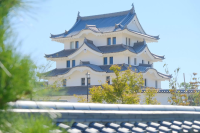Bring good luck! 7 minutes by train from Osaka Umeda Station! Day trip from Osaka to Amagasaki Teramachi and the Seven Lucky Gods

It is said that you can receive good fortune by visiting seven shrines and temples, and visiting each of them. It is a 7-minute walk from Osaka Umeda Station on the Hanshin Railway. You can walk around all seven shrines and temples from Hanshin Amagasaki Station, so it is recommended as a casual outing.
2 hours
The area around Hanshin Railway's Amagasaki Station is a good luck spot!? Visit the Seven Lucky Gods in Amagasaki Teramachi
There are many places where you can visit the Seven Lucky Gods, but Amagasaki's seven shrines and temples are concentrated around the station, making it a compact area that you can easily explore on foot.
This time, we will head to Amagasaki from Osaka Umeda Station on the Hanshin train.
See details about sightseeing in Amagasaki
Depart from Hanshin Railway's Osaka Umeda Station!
※Note※
In addition to the Hanshin Railway's Amagasaki Station, there is also the JR Amagasaki Station, but please note that the two stations are more than 2 km apart and it takes more than 30 minutes to walk there.
Start your tour of the Seven Lucky Gods from Amagasaki Station (Hanshin Railway)!
Each temple and shrine along the Seven Lucky Gods tour has a stamp stand where each person stamps their stamp.

Here, you will receive a stamp of Fukurokuju, the god who brings good fortune and success.
Here, you will receive a red seal of Bishamonten. Bishamonten is said to grant various blessings, but in the Amagasaki Teramachi Seven Lucky Gods Tour, he is said to grant the blessing of family prosperity (meaning that the family will prosper).
Daikakuji Temple enshrines Benzaiten, the goddess of wisdom and good fortune in love. She is the only female deity among the Seven Lucky Gods.
Here, you will receive a red seal of Hotei, who is said to be the god of family harmony and fertility.
Honkoji Temple is the central temple of Teramachi and was founded in 1420 during the Muromachi period.
Here, you will receive a red seal of Daikokuten. Daikokuten is also a god of good fortune who brings many benefits, but on the Amagasaki Teramachi Seven Lucky Gods Tour, he is considered to be the god of wealth and prosperity.
Here, the red seal of Jurojin is stamped. Jurojin is the god of longevity and prolonged life.
Ebisu Shrine, of course, enshrines Ebisu, the god of prosperity in business.
Now I have all seven stamps and my red seal paper is complete!

What did you think? Bring good luck and prosperity to Amagasaki. Please be sure to check it out.
There is also a direct line to Amagasaki Station from Namba Station!
This time we introduced the route from Umeda, the center of Kita, but you can also get to Amagasaki Station directly from Namba, the center of Minami.
It takes 15 minutes by rapid express from Osaka-Namba Station on the Hanshin Railway to Amagasaki Station. No transfers required.
Find out more about sightseeing in Amagasaki
Spots introduced in this itinerary
Amagasaki City is located in the southeastern corner of Hyogo Prefecture and is a core city with a population of about 450,000. Hanshin Electric Railway, JR, and Hankyu Railway run from east to west, and you can access Osaka, Kobe, Kyoto, and Nara without changing trains, and you can travel to the three Kansai airports in less than an hour, making it a very convenient city. [A town with a castle] In 1617, by order of the Edo Shogunate, the fudai daimyo Toda Ujikane became the lord of Amagasaki and built a new Amagasaki Castle. For about 250 years, Amagasaki Castle boasted its majestic appearance as the defense of the west of Osaka until it was demolished after the castle abolition order in 1873. It was rebuilt in 2019 and has once again become the symbol of the town. [A town of human kindness] Amagasaki has many shopping streets and public baths that have been bustling since ancient times, and the atmosphere of the downtown area remains throughout the town. Talking to friendly, warm-hearted older men and women gives you a sense of nostalgia and warmth. [A town where industry and the environment coexist] Amagasaki took its first steps as an industrial city with the opening of a spinning mill in the Meiji era, and has since led the country's rapid economic growth. In recent years, the city has set high goals and taken on pioneering initiatives to realize a low-carbon society, including drastically reducing greenhouse gas emissions, and was selected by the government as an "environmental model city" in 2012. *The Amagasaki Tourism Bureau was established in March 2018 with the cooperation of various stakeholders in Amagasaki to work toward creating a future-oriented tourism region unique to Amagasaki that attracts tourists, enriches the local economy, and fosters pride and attachment to the region by making the most of local resources.
The contents on this page may partially contain automatic translation.











































![[Reopening in March 2026] Ikoma Sanjo Amusement Park Park, 45 minutes from Osaka , with free admission](https://resources.matcha-jp.com/resize/720x2000/2024/08/28-194409.webp)
![[Gunma] 5 recommended gourmet foods at Kawaba Denen Plaza Roadside Station!](https://resources.matcha-jp.com/resize/720x2000/2025/02/26-225970.webp)
![[Kanazawa] Enjoy the world of gold leaf to the fullest in the city with the highest production volume in Japan](https://resources.matcha-jp.com/resize/720x2000/2025/11/12-249564.webp)
![[2026] Family Winter Trip to Suzuka Circuit! – For Both Day trips and Overnight Stays!](https://resources.matcha-jp.com/resize/720x2000/2025/12/26-254097.webp)
